Unlock your creative potential.
Recently, I received an email from a new subscriber – we’ll call her Beth (not her real name). Beth was keen to get started in thread sketching but felt intimidated by all the ‘talent’ out there in the world.
I always find it a little upsetting when people say that they don’t have the talent or skill to create art ‘as good as’ what we see in galleries and exhibitions.
It’s even worse when someone says they wish they had my talent! Oh, dear!
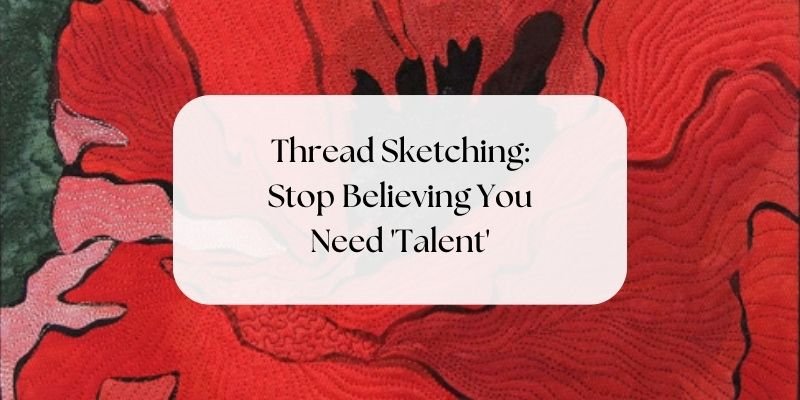
It’s easy to feel intimidated. It doesn’t matter how much ‘experience’ you have, most people understand how it feels to think that everyone else is ‘better’ than you.
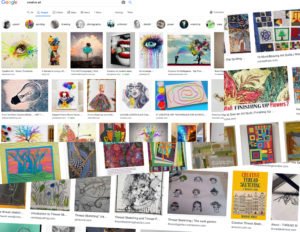
It only takes a few seconds to type a search term into our friend Google, to be swamped with images of art (stitched, quilted, painted, sketched, woven … the list goes on).
There is so much fantastic art being made by creative people, day in, day out.
Beth struggled to convince herself she could ever be ‘that good’, so I had to go to work on her!
You see, the problem was that Beth didn’t believe she had the ‘talent’ or the necessary experience to begin free motion thread sketching.
But believing you need talent and experience is only one part of the puzzle.
Think back to your childhood.
You may have heard this quote from the famous artist, Pablo Picasso:
All children are artists. The problem is how to remain an artist once he grows up.
Pablo Picasso
As a child, were you ever worried about what people thought of your drawing or writing? (No!)

Did you get exasperated when your dad couldn’t see that you’d drawn a picture of a dinosaur? (Jeepers, Dad, can’t you see it …?)
My son wrote this little storybook when he was about 5 years old … I never did work out what ‘Fits’ meant!
As a child, you had no doubts about the quality of your work then, so why do we lose that inherent trust in our artistic ability as we grow up?
The thing is, by adulthood, we’ve learned to recognise quality in other people’s work, but find it difficult to see the merit in our own.
The beliefs we form.
Stand in any art gallery, and I challenge you to spend even 30 minutes without someone near you saying, ‘Wow!’, or ‘I wish I could sew, paint, weave [insert your choice] that well. She has so much talent.’.
And yet, taking a different point of view, I wouldn’t be surprised if you’ve also had the experience of thinking, ‘How on earth did he get that exhibited? It looks like a 2-year-old painted it.’.
There are myriad reasons how and why particular artworks get exhibited, and others don’t, but that’s not the thread I want to follow today (no pun intended).
I’m talking about beliefs.
Unless you’re a prodigy like Monet or Mozart, most people are born with a healthy, but fair allotment of talent.
Even though Monet showed early prodigious talent, he struggled for much of his life to have his work recognised.
Galleries and investors were simply not interested. Not only did they think Monet’s paintings weren’t worth exhibiting but also not worth spending money on.
Why?
Because he broke the ‘rules’ of art at the time. He wanted to create art in his own style, feeling stymied by the conventions of the past.
The situation was, at times, so bad that Monet struggled to support his family, and even attempted to take his life by jumping off a bridge. (Fortunately for us – and his family – he didn’t succeed!)
It was Monet and his fellow ‘rule breakers’ – Degas, Renoir, Pissaro, and Cézanne – that we have to thank for the artistic style called Impressionism.
Monet’s art now sells for tens to hundreds of millions of dollars.
I wish I’d been around in the late 1800s to buy one when they weren’t fashionable!
Where would the world of art be without Impressionism? This movement has gone on to inspire not only painters but art quilters and thread painters, too.
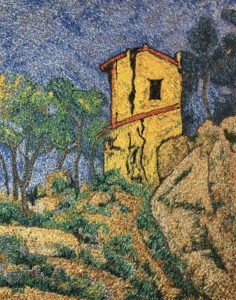
And what about Mozart? It’s fair to say he was, in all truth, a child prodigy, writing his first symphony at the age of 7.
Yet it was still many years before his greatness was recognised.
As a classical musician, I can’t bear to think of what we’d be missing out on if Mozart had never been ‘discovered’.
But I digress …
I was talking about beliefs.
The Top 5 Beliefs that hold us back as thread sketching creatives.
- I’m not artistic. The belief that you need talent. (You don’t.)
- I don’t have the training. I can’t draw. The idea that you need to have gone to art school. (No need.)
- I’ve never done this type of stitching before. The belief that you need to have prior experience. (Unnecessary.)
- I only have a basic sewing machine. The notion that you need an expensive machine. (No, you don’t.)
- People will judge my work poorly. Imposter syndrome! (This is normal. Stop and listen to the praise you get when you create something new. It may just surprise you!)
How to overcome negative beliefs.
Harking back to our friend, Beth, these five beliefs were firmly embedded in her thinking.
But by breaking the cycle, Beth was able to find her place in the creative world – a place that she truly owns. It’s her unique space.
What does it take to break out of this negative cycle of thinking?
Take the first step.
Start. Just do it (to coin a well-known phrase). Nobody needs to see your first attempts if you don’t want them to.
Make something meaningful to you.

Can you make a gift for someone? It doesn’t need to be large. Perhaps make a mug rug, or a postcard, or little framed picture.
One of my very first thread sketching projects was creating note cards with a tiny, thread sketched micro-quilt mounted on top. These cards proved so popular that I ended up making hundreds of them for colleagues and friends, and to sell.
Now keep this in mind – these cards were successful even though I’d never done anything like them before. And that first design became the prototype for numerous other card designs, as well as larger works.
You just never quite know what’s going to take off, and what isn’t!
Begin with simple shapes.
Think triangles, circles, squares. The designs that can be made with simple shapes are many.
Take a look at any abstract artist who works this way. Check out the work of Mark Rothko, or any of the Cubist artists, e.g. Picasso. Set your mind to thinking how easy it would be to translate these styles to make stunning art quilts.
Watch and learn.
The internet is awash with free tutorials and articles for beginners. You’ll find several right here on my website.
Learn by doing.
The best way to learn anything is to actually do it. Take action. Make mistakes. Learn from your mistakes. Learn from your triumphs.
Explore the possibilities. Let your imagination go wild!
You do know enough.
Don’t let self-doubt hold you back. Create something – anything – give it as a gift to someone you love. It’s a great feeling.
Nobody starts out with the skills.
As a new thread sketcher, your aim is to become comfortable with the process of free motion stitching.
Developing the ability to manipulate the stitches and manoeuvre the fabric takes a little practice.
Spending just 15 minutes or so a day practising free motion stitching will get you on the road very quickly.
‘Experienced’ artists make it look so easy!
But remember – everyone you now perceive to have ‘talent’ or ‘experience’ or ‘skill’ was, one day, just like you: a Beginner.
And how did Beth get on? Beth was, not long ago, a self-doubting novice.
But once she started letting her natural creativity shine through, she realised that her stitched art is beautiful. It’s thought-provoking and different. It’s her own. It’s unique.
You are unique, too. Embrace it.
Read a Book
If you’d like guidance in getting started, I have a range of books available.
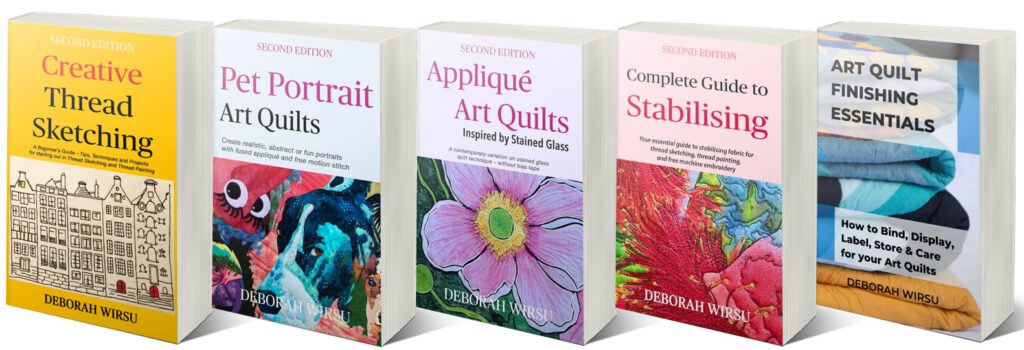
In the meantime, just get out that sewing machine and stitch something. The more you do, the more your confidence will grow.
Wherever you are on the learning curve, keep in mind that you’ll never run out of exciting things to discover.
Keep exploring. Keep stitching.
Have no fear of perfection – you’ll never reach it.
Salvador Dali
Embrace your inner creativity with joy and enthusiasm.
Remember – there are NO RULES in creative art.

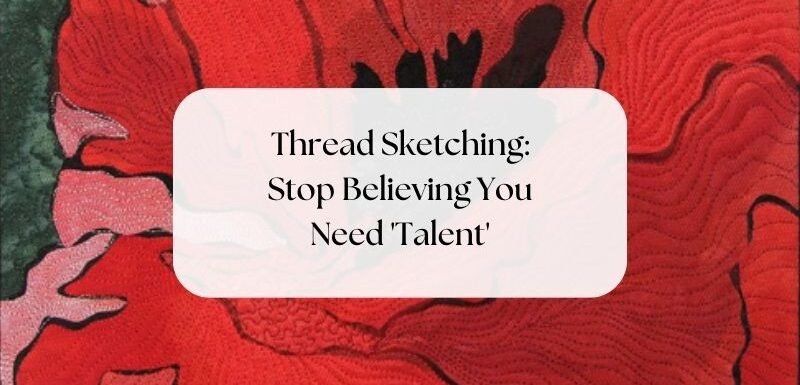
thank you for this inspiring post. I have taken one of your classes. But life has interfered with my progress. This totally inspires me and my creativity. Tine to make more me time. I love your work. I love your words. Thank you for reinspiring me!!!! B
Great point, Barbara … make more time for ‘you’. Thank you for your kind words – inspiring people brings me pleasure. Life gets in the way for all of us, from time to time, but our art and our creativity never go away … they’re always waiting for our return. 🙂 Deborah